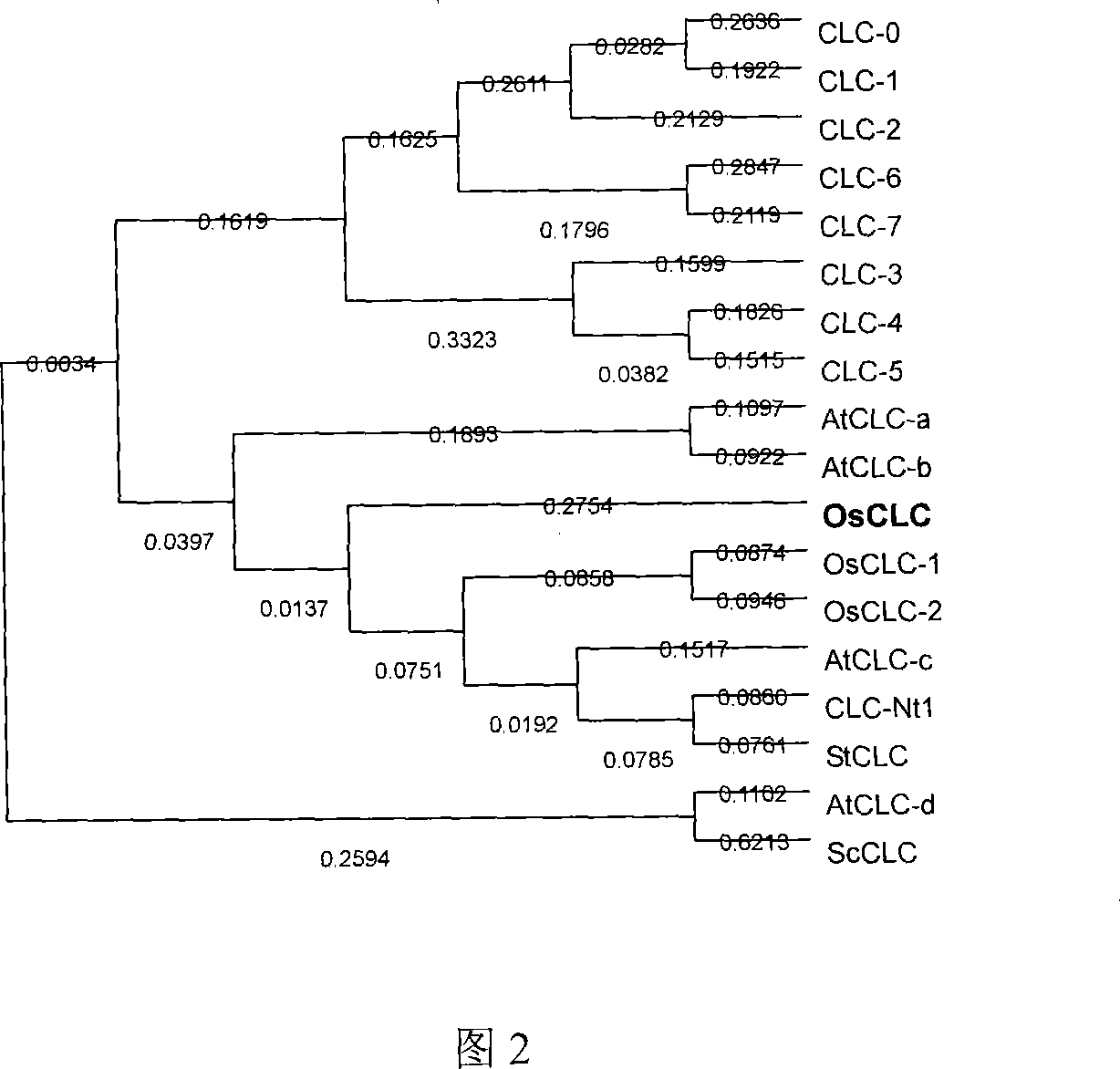Rice chlorine ion passage gene OsCLC, coding protein and clone method thereof
A technology of chloride ion channel and cloning method, which is applied in the field of rice chloride ion channel gene OsCLC, its encoded protein and its cloning, and can solve the problem of limited number of plant chloride ion channel gene reports
- Summary
- Abstract
- Description
- Claims
- Application Information
AI Technical Summary
Problems solved by technology
Method used
Image
Examples
Embodiment 1
[0025] Cloning and analysis of the full-length coding region of OsCLC
[0026] (1) Preparation of differentiated callus
[0027] Peel off the chaff of mature rice seeds, rinse with 70% ethanol for 1 min, soak in 0.1% mercury liter for 20 min; rinse with sterile water for 4-5 times, inoculate on MS+2, 4-D 2 mg / L induction medium, and place in the dark Culture the induced callus at 26°C; after two weeks, put the callus on the differentiation medium MS+6-BA2mg / L+KT2mg / L+NAA0.2mg / L, collect the differentiated callus, and Stored at -80°C after nitrogen snap freezing.
[0028] (2) Extraction of total RNA
[0029] The total RNA of rice differentiated callus was extracted by the Trizol method, and the total RNA was used as a template, and Oligo(dT) was used 18 As a primer, reverse transcription to synthesize the first strand of cDNA, Oligo(dT) 18 They are:
[0030] The 5' end primer is 5'-CGATGGCGCCAAGGGACCAGTCAT-3',
[0031] The 3' end primer is 5'-TACTAGCGAGCGTCAGAAGACGAG-3', ...
Embodiment 2
[0035] Real-time fluorescent quantitative PCR detection of salt-induced OsCLC gene expression
[0036](1) Sample preparation
[0037] A pair of specific primers were designed according to the sequence of the rice OsActin gene (Genbank: X15865): 5'-end primer (5'-TTG TGA GGG ACA TGA AGG AGA A-3'); 3'-end primer (5'-TAT GAA GGA AGG CTGGAA GAG G-3′) fragment length is 193bp, which is used as an internal reference for real-time fluorescence quantitative PCR. Design a pair of specific primers for the target gene OsCLC, 5'-end primer: 5'-ACA TCG TAT TTC CTG GGC ATT T-3'; 3'-end primer: 5'-CAG TCA TTC TCA TTG ATC CTC C-3' , the fragment length is 179bp. Using the first strand of cDNA synthesized in Example 1 as a template, the PCR reaction program was 94°C, 5min, and the following 30 cycles were performed: 94°C, 20s, 57°C, 20s, 72°C, 20s; finally, 72°C extension for 5min. Then, the two products were ligated into the pMD19-T vector and transformed into DH5α, and positive clones wer...
Embodiment 3
[0049] Mutant functional complementation experiment
[0050] (1) Construction of recombinant plasmids
[0051] Using the first strand of cDNA synthesized in Example 1 as a template, design specific primers: 5' end primer containing Sac I site (5'-AGC TGA GCT CGA TGG CGC CAA GGG ACC A-3'); containing Xbal 3' end primer of I (5'-TAG CTC TAG AGA AGA CGA GGT TGG TGA A-3'). The resulting product was digested with Sac I and Xbal I and inserted into the shuttle vector pYES2, and the recombinant expression plasmid pGAL1::OsCLC (Apr + ), the positive clone obtained by Apr screening, the plasmid was identified as positive by Sac I and Xbal I digestion, and then the lithium acetate method was used [12] Transformed into the Saccharomyces cerevisiae mutant strain YJR040W (gef1::kam), in CM omitted component medium (Ura - ), pGAL1::OsCLC (Ura + ) and pYES2 empty vector transformant yeast colonies, extract yeast DNA as a template, and use the OsCLC gene-specific primers designed in Secti...
PUM
 Login to View More
Login to View More Abstract
Description
Claims
Application Information
 Login to View More
Login to View More - R&D
- Intellectual Property
- Life Sciences
- Materials
- Tech Scout
- Unparalleled Data Quality
- Higher Quality Content
- 60% Fewer Hallucinations
Browse by: Latest US Patents, China's latest patents, Technical Efficacy Thesaurus, Application Domain, Technology Topic, Popular Technical Reports.
© 2025 PatSnap. All rights reserved.Legal|Privacy policy|Modern Slavery Act Transparency Statement|Sitemap|About US| Contact US: help@patsnap.com



